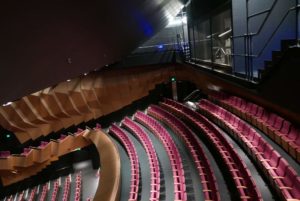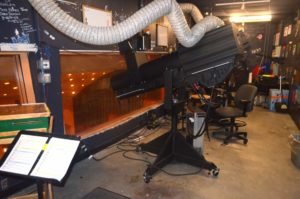Did You Know – Follow Spot Rooms
Follow spotlights have been a vital stage lighting tool for many decades, primarily used to highlight a performer on stage who is moving or dancing. We are all well aware of the noticeably bright, crisp circle of light surrounding a spot-lit performer, and in many cases that bright circle also illuminates everything behind the performer – scenery, curtains, cycloramas, and video screens – which may be an acceptable visual for rock concerts but less so for modern musical theatre and opera productions.
Today, theatre and opera lighting designers desire the ability to highlight performers magically, using higher angles and softer edges. In smaller drama theatres, higher angles can often be created within the front of house catwalk system using narrow-beam ellipsoidal spotlights with special hardware. But for larger theatres, the more powerful follow spots usually integrate cooling fans and must be enclosed for sound isolation. In these cases, one or more rooms must be built with glass fronts, and require cooling and adequate power for the lights. The ideal locations of these rooms are generally high in the auditorium, providing a roughly 40-degree (from horizontal) lighting angle to a performer at the plaster line of the stage. Sometimes, this ideal lighting angle can be accommodated by locating the follow spot rooms at the rear wall of the auditorium just below the ceiling line; however, it is often necessary to locate the follow spot rooms closer to the stage to achieve a more ideal lighting angle.

View of follow spot room at Bunjil Place, City of Casey, Victoria, Australia. Photo by Jim Hultquist, ASTC
These kinds of locations rarely coincide with a front of house or auditorium floor level, so personnel access must be given special consideration. For organizations that desire disabled access to as many technical positions as possible, this becomes even more of a challenge, and it may be argued that physical disabilities do not necessarily preclude the operation of a follow spot; some technicians who cannot easily climb stairs may still be able to operate a follow spot. In addition to personnel access, follow spot rooms also require equipment access, so follow spots may be removed for maintenance or replacement. This type of access often involves lifts or hoists, since follow spots cannot always be easily carried on stairs.
While the typical accommodation of follow spots and booths largely follows conventional design methods, recent technology has introduced LED-powered follow spots for short- and medium-throw applications, as well as remote-controlled follow spots, which currently require a substantial investment for purchase.
By Robert Shook, FASTC
Disclaimer: Any views or opinions expressed in this article are solely those of the author and do not necessarily represent those of the American Society of Theatre Consultants. This article is for general information only and should not be substituted for specific advice from a Theatre Consultant, Code Consultant, or Design Professional, and may not be suitable for all situations nor in all locations.



